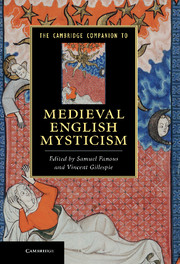Book contents
- Frontmatter
- Contents
- List of contributors
- Preface
- Chronology
- List of abbreviations
- 1 Introduction
- 2 c. 1080–1215: culture and history
- 3 c. 1080–1215: texts
- 4 1215–1349: culture and history
- 5 1215–1349: texts
- 6 1349–1412: culture and history
- 7 1349–1412: texts
- 8 1412–1534: culture and history
- 9 1412–1534: texts
- 10 1534–1550s: culture and history
- 11 1534–1550s: texts
- Guide to further reading
- Glossary of theological terms
- Index
- References
8 - 1412–1534: culture and history
Published online by Cambridge University Press: 28 July 2011
- Frontmatter
- Contents
- List of contributors
- Preface
- Chronology
- List of abbreviations
- 1 Introduction
- 2 c. 1080–1215: culture and history
- 3 c. 1080–1215: texts
- 4 1215–1349: culture and history
- 5 1215–1349: texts
- 6 1349–1412: culture and history
- 7 1349–1412: texts
- 8 1412–1534: culture and history
- 9 1412–1534: texts
- 10 1534–1550s: culture and history
- 11 1534–1550s: texts
- Guide to further reading
- Glossary of theological terms
- Index
- References
Summary
For of old custom it longith unto kynges
First holy chirche to meyntene and goverene
And for ther sogetys in al maner thynges
For to prouyde and prudently discerne
To showe themseylf lyk a clere lanterne
With lyght of verteu ther sogettys tenlumyne
Both by example and vertuous doctryn.
John Lydgate, Cartae versificataeStrong kings with a mission to reform their national churches mark the beginning and end of this period. The two Henries (V and VIII), both lavishly gifted and devout sons of usurping monarchs, sought to reform their ecclesiastical inheritances as part of a policy of buttressing their own imperial power. But whereas Henry V aligned his church more closely and immediately with the international struggle against heresy and schism, and with a movement for radical reform of the institutions and life of Christianity, Henry VIII, despite closely and deliberately imitating the political and religious example of his illustrious namesake, ended up isolated from the universal church and from most of its Protestant offshoots. The defender of the faith (defensor fidei) became known as the destroyer of faith (destructor fidei). Yet the different outcomes should not cloud the very real similarities between their attitudes to the ecclesia anglicana (the English Church, a phrase that would have been familiar to both).
- Type
- Chapter
- Information
- The Cambridge Companion to Medieval English Mysticism , pp. 163 - 194Publisher: Cambridge University PressPrint publication year: 2011
References
- 1
- Cited by



